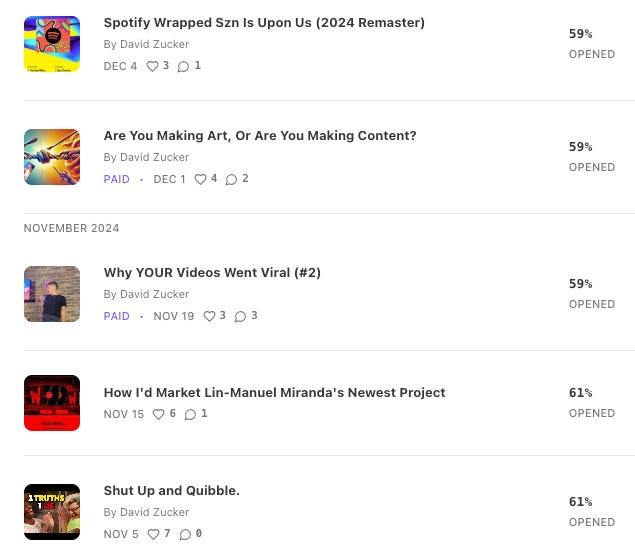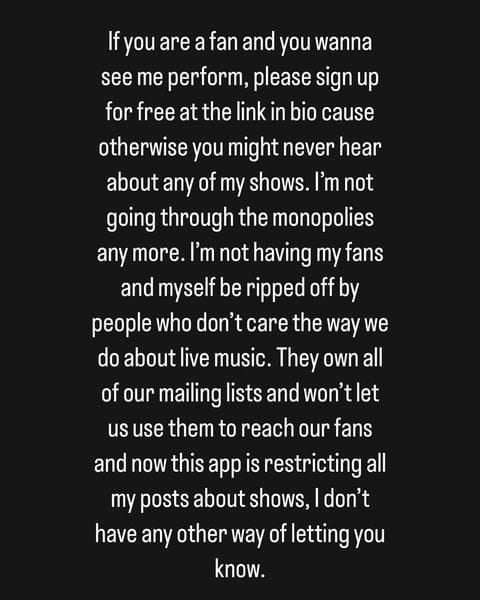Hello all, quickly popping in to let you know I just filed a new column over at Cramer Comedy Newsletter. Normally, I would only promote my work over there on my Instagram, but Instagram and Facebook are down at the moment, which is oddly fitting.
If you’ve missed any of my monthly articles at CCN in 2024, here are some links to my breakdowns on why comedians went viral in January, February, March, April, May, June, an Edinburgh Fringe Edition, a new SNL Cast Member edition, a YouTube deep dive, and an election edition.
Many artists seem to think ~the algorithm~ “suppresses” their Instagram Reels, Grid Posts, or Stories when they pivot from posting high-quality live footage and made-for-digital sketches to posting about an upcoming show or tour.
This fear does not only exist in the Brooklyn alternative comedy scene, but across all verticals of live performance, at all levels of starpower.
This 12-part Instagram carousel post from two-time Grammy Award-winning musician James Blake summed up the artist’s frustration with Instagram perfectly.
Highly recommend reading the full post before moving forward, but here are some notable pull quotes. Bolding done by me:
Caption:
@jamesblake: This is a thing me and other artists have been noticing for a long time, not just today. I want artists and fans to be truly reconnected. Having an instagram following means nothing any more if you can’t reach your fans.
Slide #2:
Are any of you actually seeing these posts about shows I’m putting on? I’m seeing crazy bottlenecking. 3,000 views on a story when I have 691,000 followers1 .. grid posts reaching hardly anyone.. why can’t I promote a show to people who follow me? How else am I supposed to let people know I’m playing?
Final Slide:
To all artists out there - the humble mailing list is your way out of this.
Blake’s vulnerability here is admirable, especially for someone at his level of fame.
But I think a lot of artists forget the context in which their profiles reside online.
These apps only exist for “free” use because advertisers pay billions of dollars for thousands of commercial slots in front of millions of eyeballs a day.
And the reason there are millions of captive eyeballs every day is because thousands of artists, content creators, influencers, comedians, musicians, athletes, James Blake, etc. upload such great and compelling content onto their profiles organically, that people are willing to be served an ad every five Reels or three Stories, in exchange for continuing along on their infinite scroll of free entertainment, several hours per day.
More cynically, the financial interests of Meta are a little bit at odds with Blake’s 40+ two-hour concerts. That’s 80+ hours where thousands of people could have been on their phones, watching dozens of advertisements instead.
But James Blake the organic video poster is a categorically different Instagram user than James Blake the musician with a tour to promote, and tickets to sell.
At the risk of bootlicking, I’m a little inclined to side with the social media platforms here.
For the people reading this over the age of 35 – when you post an Instagram Story, it disappears after 24 hours. This is a feature Instagram adopted2 from Snapchat in 2017.
But just because James Blake checks his Instagram every day, it doesn’t mean that all of his 691,000 followers do, too.
Dozens of them may only check Instagram once a week.
Hundreds might open the app once a month.
Thousands are definitely fake spam accounts created halfway across the world.
And the ones that do check Instagram daily are mainly seeing Stories of their camp friend’s cousin’s engagement party, or their sorority sister’s bachelorette weekend.
Occasionally, they may see a promotional post pop up from their favorite comedian, podcaster, musician, or influencer they follow. But they typically only follow those people because they like looking at or being entertained by them.
Nothing more, nothing less.
Startups call this optimizing for DAU/MAU, or the ratio of daily active users vs. monthly active users, and getting that ratio as close to 1 as possible.
The true amount of DAJBF3 might be closer to 5% of that total “perceived reach” of 691K, or roughly 34,550 people.
In that case, reaching 8-9% of them with an Instagram Story (3,000, per his carousel post), is honestly… pretty standard for organic promotional Instagram stories.
But this is why Instagram Business accounts exist.
It’s pay-to-play, sure, but they guarantee you reach, especially if you target the right audience with geographic and psychographic data.
Remember when we all liked 500 Facebook pages in 2010-11 for no reason?
In 2024, all of that Affinity data can be incorporated into your Instagram paid spend.
You can set up a campaign that only targets people within a 10-20 mile radius of your show venue. And if you really know your audience, you can target Instagram users based on additional interests they liked on Facebook back in the day (for instance, the “James Blake” Facebook page with 776K+ followers), and guarantee your ad reaches the exact people nearest to the exact venues you’re slated to perform in.
If you work backwards based on unsold venue capacity in each city, ticket price, and the standard conversion percentage of total impressions to ticket purchases (2% CPA or better would be great, in Blake’s case), you can easily set up a comprehensive social media budget and sell out your arena tour with minimal, hypertargeted paid spend.
I don’t know about you all, but that actually sounds pretty artist-friendly to me.
However, I 100% agree with Blake that artists should absolutely strive to own the delivery of their own messages to their own audience.
I’ve written about this before, but as long as comedians (and all artists, really) are heavily reliant on unpredictable distribution networks that are effectively glorified commercial booking agencies, I worry artists will always be beholden to outside forces, and themselves forced to adapt accordingly.
Hell, this email is literally being sent as Instagram and Facebook are down.
Imagine if these apps went dark for a sustained period of time, or got banned entirely.
…
This is why I advocate for all my clients to funnel their social media followers to a mailing list.
Like this one.
Speaking from personal experience, I’d much rather grow this newsletter delivered to 1,220+ readers with a 95-100% delivery rate and a 50-60% open rate, than focus on my 38.3K+ TikTok followers and 11.4K+ Instagram followers who rarely view my Stories.
My average email open rate from my last five emails I’ve sent out is 60%, meaning well over 600 people have received and opened each email I’ve sent in the last six weeks:

Meanwhile, my Instagram page has 11.4K followers, and it’s exceptionally rare if 600 of them ever view my Story. The most Views I’ve ever gotten on any Instagram Story I’ve ever posted is a little over 1,000, or fewer than 10% of my “perceived total reach”.
Even though it’s only a tenth of the “total size” of my Instagram followers, and about 3% of my TikTok following, my mailing list is already reaching more people more consistently than my Instagram Stories.
That’s why Blake’s overarching point is bang-on: a mailing list is a significantly more valuable entity at scale, even if the ceiling for perceived total reach on social is higher.
But what if I told you there’s a way to promote your shows on Instagram organically?
David Zucker is a digital marketing consultant based in New York City. A former analyst at TikTok, his unique, data-driven approach has catapulted the growth of his international client base of comedians and companies within the entertainment industry. To set up an initial consultation, click here.
In other words, 0.434% of his total IG follower count.
(stole)
Daily Active James Blake Followers




This was a good read
Very nice read, thank you. I have come up to quite the same conclusions. Moreover, the artist you quote says "they own the list" and that is another core issue: Instagram owns your contacts, not you. In Substack instead, you own your audience. Here is my text, similar to yours that explains this in detail: https://open.substack.com/pub/4two/p/how-to-own-your-audience